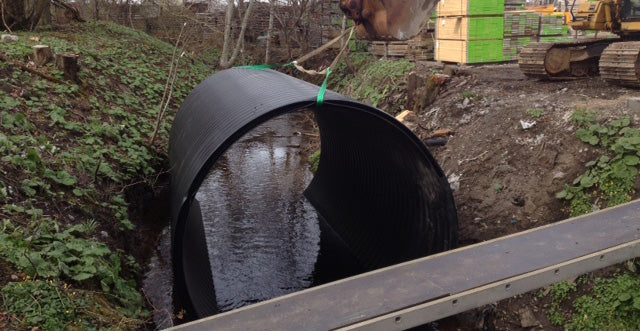Precision Pad Construction for Secure Structures
Precision Pad Construction for Secure Structures
Blog Article
Attain Success With Culvert Setup: Best Practices Exposed
Mounting culverts is a vital element of infrastructure advancement, needing precision and adherence to best techniques for long-term success. Whether embarking on a new job or maintaining existing culverts, the process needs careful focus to detail. From the first material selection to the last stages of maintenance, each action plays an essential role in the functionality and longevity of the culvert system. In this conversation, we will discover necessary methods, suggestions, and standards that can dramatically impact the outcome of culvert installations. Understanding these key elements is vital in making certain the structural stability and efficiency of culverts, making it critical for specialists and enthusiasts alike to comprehend these foundational principles.
Correct Material Choice

Concrete culverts are understood for their stamina and resilience, making them ideal for hefty traffic areas and huge water flow volumes. Corrugated steel culverts are lightweight and easy to mount, excellent for short-term applications or situations calling for a fast solution. Plastic culverts are light-weight, corrosion-resistant, and economical, making them a popular choice for various culvert installations. Compound products supply a combination of residential properties from different materials, offering an adjustable remedy for certain job needs. Ultimately, picking the appropriate material is essential to make certain the culvert system functions efficiently and has a long solution life.
Website Preparation Tips
Efficient site prep work is important for the successful installation of culverts, making sure proper combination with the surrounding atmosphere and long-lasting performance. Prior to starting the setup procedure, it is crucial to conduct a comprehensive site evaluation to determine the suitable size, type, and positioning of the culvert.
Following, the dirt problems ought to be evaluated to assess the security and load-bearing capability of the ground. Depending on the soil type, added procedures such as compaction or reinforcement may be necessary to stop clearing up or changing of the culvert over time. Proper drainage considerations need to also be thought about to avoid water buildup around the culvert, which can cause erosion or architectural damages.
Finally, establishing proper access to the website for building devices and ensuring conformity with any regulative needs are vital facets of site prep work. By adhering to these site preparation suggestions, the like it setup of culverts can be accomplished effectively and efficiently, advertising the long life and performance of the culvert system.
Installment Methods

To start with, it is necessary to precisely measure and note the place where the culvert will certainly be installed. The trench needs to be dug to the right deepness and size, taking right into account the dimension and kind of culvert being mounted.
Next, the culvert needs to be positioned in the trench following the manufacturer's guidelines. Proper positioning is vital for the performance and long life of the culvert. Backfilling the trench with the ideal material and condensing it in layers is the final step that site in the setup procedure. This makes sure the culvert is firmly in position and ready to hold up against the demands it will deal with. By complying with these installation techniques carefully, the culvert will be efficiently mounted, adding to the overall success of the job.
Maintenance Standards
After finishing the careful setup of culverts following proper techniques, adherence to maintenance standards is paramount to ensure their longevity and capability. Routine inspection is crucial to recognize any indications of wear, blockages, or architectural damage early. Evaluations ought to consist of checking for debris buildup, disintegration around the culvert sides, and any signs of corrosion or corrosion. Clearing debris, such as branches or leaves, from the inlet and outlet routinely is necessary to avoid obstructions that can lead to flooding.
Additionally, maintaining proper incline and placement of the culvert is vital for efficient water flow and to protect against possible obstructing. Road construction. Any kind of vegetation near the culvert should be managed to prevent root breach and blockages. In locations vulnerable to freezing temperatures, implementing wintertime maintenance techniques such as making sure correct drain to avoid ice accumulation is important
Normal upkeep not only prolongs the lifespan of culverts however also guarantees they function properly in handling water flow, minimizing the risk of damages to facilities and surrounding areas.
Troubleshooting Common Issues
Attending to common concerns that may develop with culverts requires an organized technique and mindful analysis of the underlying click to find out more causes. One regular problem run into is obstructions within the culvert, frequently triggered by debris buildup or sediment build-up. To fix this problem, normal inspections and upkeep are essential to guarantee appropriate functioning. Additionally, improper setup leading to imbalance or insufficient slope can cause water flow disturbances or perhaps architectural damages. By examining the culvert alignment and slope on a regular basis, possible issues can be recognized and corrected immediately.

Verdict
In verdict, attaining success with culvert installation requires mindful factor to consider of material choice, complete website prep work, appropriate setup techniques, and regular maintenance. By following finest techniques and troubleshooting typical problems, the stability and functionality of culverts can be made certain. It is necessary to follow standards and suggestions to avoid any prospective problems and make certain the durability of the culvert system.
Report this page